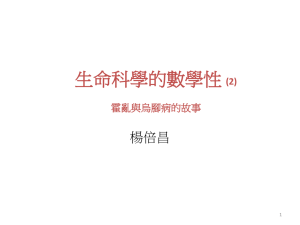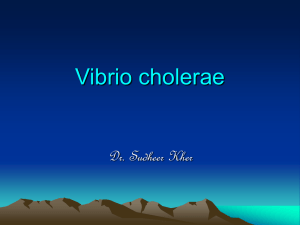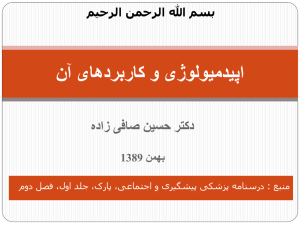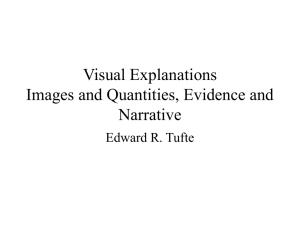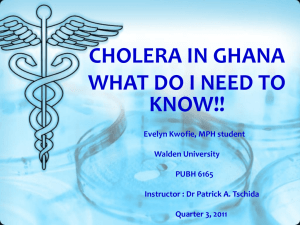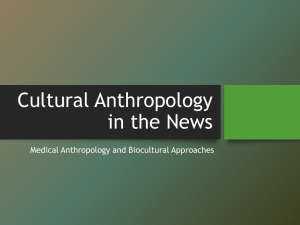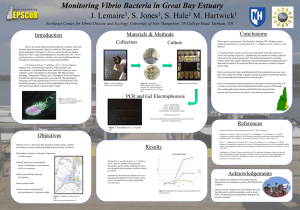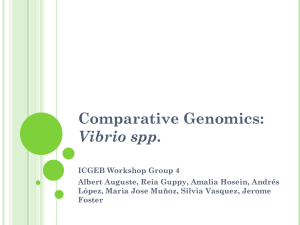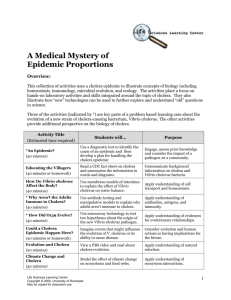Chin_Cholera
advertisement
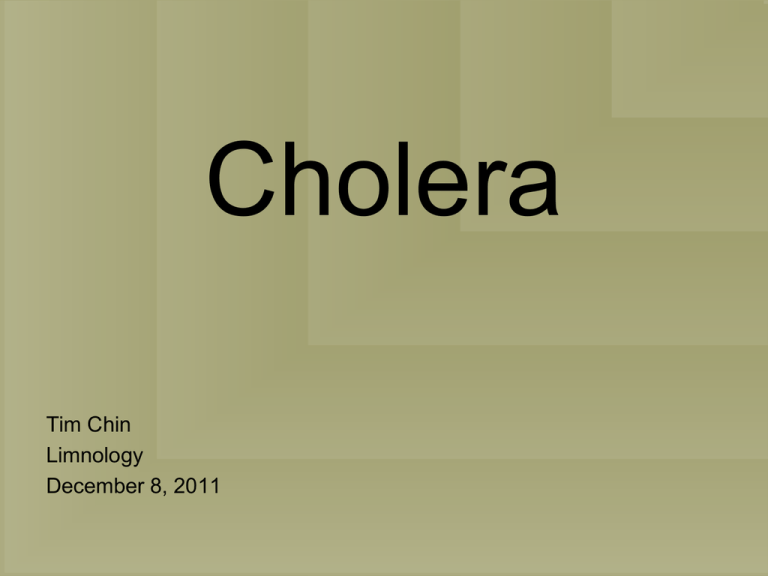
Cholera Tim Chin Limnology December 8, 2011 Waterborne Diseases • Illnesses transmitted through the consumption of contaminated water • Water acts as a passive host for waterborne pathogens • Caused by a bacterial, viral, or protozoal agent Cholera • The first waterborne disease to be associated with water as its source • Characterized by profuse watery diarrhea, sometimes along with leg cramps and vomiting • Only 5% of infected individuals display severe symptoms • Can cause death in untreated cases within a matter of hours from dehydration and shock • Caused by the bacteria Vibrio cholerae Vibrio cholerae • A member of the Vibrionaceae family • A short curved bacilli • Gram-negative • Motile Life Cycle and Ecology • Was once believed to be a obligate pathogen, unable to survive outside of the human intestine • Has been found to be a facultative pathogen • Has both human and environmental stages in its life cycle • An indigenous member of oceanic and aquatic ecosystems • Thrives best in brackish environments Life Cycle and Ecology • Organisms which are significantly similar to Vibrio cholerae have been found around deep ocean hydrothermal vents • Ancestral home has been speculated to be the deep ocean due to its affinity for salt and the samples found near oceanic hydrothermal vents Life Cycle and Ecology • Can exist as both a free-living organism and a resilient biofilm aggregate • Possesses the ability to secrete chitinase, allowing it to colonize chitinous surfaces • Is often found as a biofilm on copepods, specifically on the oral and egg sac regions Life Cycle and Ecology • The human stage of its life cycle begins once enough Vibrio cholerae are ingested by a human host • 10^6 - 10^11 colony-forming organisms is the infectious dose • Only 10^3 organisms need to be consumed if the stomach’s acidity is neutralized beforehand • Colonizes the small intestine where it induces a diarrheal discharge Life Cycle and Ecology • Hyperinfective Vibrio cholerae leaves the human host alongside fecal matter and collects on temporary reservoirs • Hyperinfective state lasts for several hours, allowing for a rapid localized spread • Repeats the cycle as more humans are infected Life Cycle and Ecology Vibrio cholerae Classification • Categorized into serogroups based on variations in somatic O antigens • About 200 serogroups of Vibrio cholerae are known to exist • Only serogroups O1 and O139 are associated with cholera epidemics and pandemics • Members of the O1 and O139 serogroups possess genes which enhance their virulence • Virulence genes code for the production of cholera-toxin and toxin co-regulated pilus colonizing factor Disease Mechanism • Secreted cholera-toxin binds to receptors on epithelial cells of the intestines and enters the cells through endocytosis • Causes a cascade of biochemical reactions, including a high production of cyclic AMP, an inhibition of sodium uptake, and the secretion of chloride ions • Biochemical processes cause an alkaline and electrolyte-rich fluid to build up in the intestinal lumen • Fluid buildup provokes a diarrheal discharge Historical Cholera Outbreaks • Records of cholera outbreaks go back as far as 2,500 years • Modern history of cholera starts in 1817, where an epidemic in India spread across the continent to southeast Asia, becoming the first cholera pandemic • 5 additional pandemics have occurred in the 19th century which mostly affected the continents in the southern hemisphere and later extended to Europe and North America • The seventh and most recent pandemic which lasted from 1961 to 1994 spread to Africa and South America Historical Cholera Outbreaks Cholera Incidence and Spread • Outbreaks are common around September when zooplankton populations increase due to phytoplankton blooms • Tends to arise in impoverished areas where sanitary procedures are lacking • Affected by temperature, salinity, and pH • Global weather patterns also play a role – Positive link between the number of cholera cases and the occurrence of El Niño Effects on Health and Economy • 3-5 million cases of cholera every year • Causes around 100,000 deaths each year • Costs associated with a cholera outbreak include the costs of healthcare, medicine, and testing • Other economical burdens are a loss of productive time and decreases in both trade and tourism • For example, a 1991 cholera outbreak in Peru cost the country over $770,000,000 Present Concerns • Cholera poses a threat to developing countries, where people lack access to clean water • Not a concern in the United States or other developed countries Cholera Treatment • Cholera is easily treatable, reducing fatalities to far below 1% • Treated with rehydration therapy – Through fluid intake – Rehydration salts • Antibiotics are administered in severe cases Cholera Prevention • Securing a source of clean water • Construction of water treatment plants • Adopting better sanitation practices • Education Image Sources • http://images.wellcome.ac.uk/indexplus/result.html?_IXMAXHITS_=1&_IXACTION_=query&_IXFIRST_=1&_IXem ailreal=true&_IXbox=259048&_IXSPFX_=templates%2Ft&_IXFPFX_=templates%2Ft • http://www.grida.no/graphic.aspx?f=series/vg-water2/0291-choleraspread-EN.jpg • http://earthobservatory.nasa.gov/Features/OceanCarbon/ • http://www.chinookmed.com/cgi-bin/category.cgi?item=18120 • http://jhyoung.myweb.uga.edu/Waterborne.html • http://www.noc.soton.ac.uk/chess/education/edu_htv.php • http://www.waterencyclopedia.com/Tw-Z/Wastewater-Treatment-and-Management.html • http://neerfoundation.org/water-borne-diseases.html • Nelson, E. J., Harris, J. B., Morris, J. G., Calderwood, S. B., & Camilli, A. (2009). Cholera transmission: the host, pathogen, and bacteriophage dynamic. Nature Reviews | Microbiology. v. 7, p. 693-702. References • • • • • • • • • • • • • Barua, D. & Greenough, W. B. (1992). Cholera. New York, NY: Plenum Publishing Corporation. CDC. (2011). Cholera. Centers for Disease Control and Prevention. Retrieved on November 23, 2011 from http://www.cdc.gov/cholera/general/. Colwell, R. R. (2004). Infectious disease and environment: cholera as a paradigm for waterborne disease. International Microbiology. v. 7, n. 4, p. 287-289. Hartley, D. M., Morris, J. G., & Smith, D. L. (2006). Hyperinfectivity: a critical element in the ability of Vibrio cholerae to cause epidemics? PLoS Medicine. v. 3, i. 2. Hunter, P. R. (1997). Waterborne disease: Epidemiology and ecology. Chichester, West Sussex: John Wiley and Sons. Huq, A., Small, E. B., West, P. A., Huq, M. I., Rahman, R., & Colwell, R. R. (1983). Ecological relationships between Vibrio cholerae and planktonic crustacean copepods. Applied and Environmental Microbiology. v. 45, n. 1, p. 275-283. Kabir, S. (2005). Cholera vaccines: the current status and problems. Reviews in Medical Microbiology. v. 16, n. 3, p. 101-116. Kirigia, J. M., Sambo, L. G., Yokouide, A., Soumbey-Alley, E., Muthuri, L. K., & Kirigia, D. G. (2009). Economic burden of cholera in the WHO African region. BMC International Health and Human Rights. v. 9, n. 8. Leclerc, H., Schwartzbrod, L., & Dei-Cas, E. (2002). Microbial agents associated with waterborne diseases. Critical Reviews in Microbiology. v. 28, n. 4, p. 371-409. Magny, G. C., Murtugudde, R., Sapiano, M. R. P., Nizam, A., Brown, C. W., Busalacchi, A. J., Yunus, M., Nair, G. B., Gil, A. I., Lanata, C. F., Calkins, J., Manna, B., Rajendran, K., Bhattacharya, M. K., Huq, A., Sack, R. B., & Colwell, R. R. (2008). Environmental signatures associated with cholera epidemics. Proceedings of the National Academy of Sciences of the United States of America. v. 105, n. 46. Nelson, E. J., Harris, J. B., Morris, J. G., Calderwood, S. B., & Camilli, A. (2009). Cholera transmission: the host, pathogen, and bacteriophage dynamic. Nature Reviews | Microbiology. v. 7, p. 693-702. Reidl, J. & Klose, K. E. (2002). Vibrio cholerae and cholera: out of the water and into the host. FEMS Microbiology Reviews. v. 26, p. 125139. WHO. (2011). Global epidemics and impact of cholera. World Health Organization. Retrieved on November 23, 2011 from http://www.who.int/topics/cholera/impact/en/index.html.

